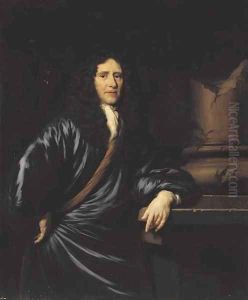Nicolas Maes Paintings
Nicolas Maes, born in January 1634 in Dordrecht, Netherlands, was one of the most prominent Dutch painters of the 17th century, particularly renowned for his work during the Dutch Golden Age. Initially trained in his hometown, Maes moved to Amsterdam at a young age to apprentice under Rembrandt van Rijn around 1650. This period under Rembrandt greatly influenced Maes's early works, which were characterized by detailed biblical scenes and historical representations, mirroring the dramatic chiaroscuro and emotional depth typical of his mentor's style.
After returning to Dordrecht in the mid-1650s, Maes's style underwent a significant transformation. He shifted his focus towards genre painting and portraits, for which he is best known today. His genre scenes, often set in domestic interiors, are celebrated for their intimate portrayal of everyday life, capturing moments of quiet reflection, household tasks, and the interactions between servants and their masters with a keen eye for detail and a warm, vibrant palette. These works are marked by a distinctive use of light and shadow, a skillful incorporation of moral themes, and a focus on the virtues of domestic life, reflecting the Calvinist values prevalent in Dutch society at the time.
In the latter part of his career, after moving to Amsterdam in 1673, Maes developed a more elegant and refined portrait style, becoming one of the city's leading portraitists. His later portraits are noted for their sophisticated use of color, detailed rendering of fabrics and textures, and the psychological depth with which he depicted his sitters. Despite the changes in his artistic focus over the years, Maes's work remained rooted in the traditions of the Dutch Golden Age, emphasizing realism, attention to detail, and a profound understanding of human character.
Nicolas Maes's contribution to Dutch art is significant, bridging the gap between the detailed narrative works of the early Golden Age and the more intimate, genre-based focus that characterized its later period. His ability to evolve artistically, mastering both the grand biblical scenes of his early career and the subtle, insightful portraits and genre scenes of his later years, demonstrates his versatility and skill. Maes passed away in Amsterdam in December 1693, leaving behind a legacy that continues to be celebrated for its insight into 17th-century Dutch life and its enduring beauty.
